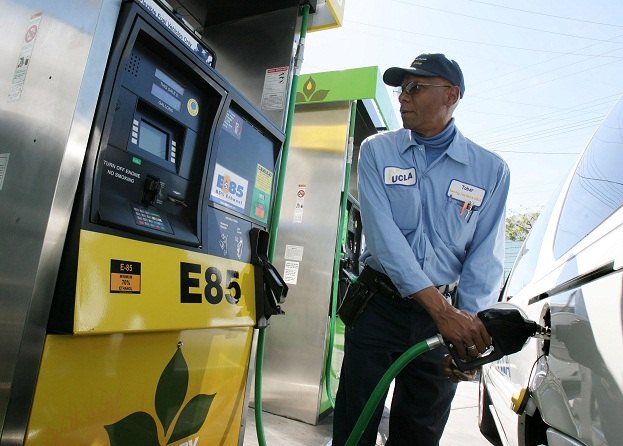Ethanol: Home Grown Fuel Source or a Source for Debate?
Posted on Mar 25, 2015 in Technology | 1 comment

E10, E15, E20 and the extreme E85 mixed fuels has been entering the vocabulary of modern motorists at a fuel station. Gasoline blended with ethanol, an organically produced substance some rather many alluring properties. Reducing hazardous emissions and acting as a natural octane booster, ethanol is currently added to fuel station gasoline.
Over the years, the support of ethanol expansion in the United States has been an issue of by-partisan approval. Creating jobs, decreasing dependence on oil from other countries and the zeroing-in on a more environmentally friendly fuel source, ethanol production has been an extremely tempting industry. Receiving growing enthusiasm, the ethanol industry has faced challenges by critics in government. This week in Washington D.C., some major arguments for and against the government funding of ethanol infrastructure has been shouted across the Senate floor.
Oklahoma Senator Dr Tom Coburn’s has been strongly objecting to the continuation of subsidiaries to the ethanol industry. Tax credits said to be worth up to 6 billion dollars to production of ethanol-blended gasoline, the savings have helped allow a more competitive price for fuels to the consumer. Senator Coburn claims the ethanol industry tax credits would have no effect on the ethanol producers. The American Coalition for Ethanol (ACE) opposes Coburn saying that the less of the industry tax credits could lead to 112,000 jobs lost and a decrease in production of up to 38 percent. For this reason, ethanol advocates worked to effectively persuaded the Senate to vote down the Oklahoma Senator’s amendment to eliminate the incentives. ACE Executive Director Brian Jennings reacted to the news saying, “This vote is a major victory for the biofuels industry and American consumers and a setback for those clinging to our status-quo dependence on oil.”
Though Senator Coburn’s argument against ethanol is focused largely on whether multi-billion dollar tax incentives are needed by for the fuel companies, some factors of ethanol itself have left many critical on the renewable resources use in vehicles. Performance-related shortcomings of ethanol fuels compared to pure gasoline have been slightly reduced vehicle fuel mileage, shorter storage life and being potentially damaging to some fuel systems. The later issue is not so much an issue for automobiles built since the early 1980s forward for lower E10 blend fuels but problems have cropped up in smaller gas engines for items such as lawn movers and snowblowers. Due to engine computers (or technically called On-Board Diagnostic units), many newer vehicles can adapt to varying levels of ethanol without driving difficulties. While most modern vehicle engines can run E10 or up to 10 percent mixtures of ethanol in gasoline, vehicles built prior to the mid 1990s will not likely manage higher ethanol levels. Recent automobiles built with Flex Fuel capabilities are calibrated to run E85 or 85 percent ethanol content. Also in reaction to more corrosive properties of higher ethanol grade fuels (such as the type that run in E85 Flex Fuel vehicles), fuel lines are typically fitted with less corrosive aluminum construction.
Many opponents for ethanol production in the United States have taken issue with the source of fuel. The United States Department of Agriculture had reported in June of 2008 that the increase in ethanol production is responsible for an up to 4 percent increase in food prices. It was also shown in the same USDA report that there is a 5 percent drop in corn being supplied for food while other uses such as livestock feed and ethanol production has significantly increased. In 2007, 2.3 billion bushels of corn were devoted to the formulation of United States ethanol.

Indeed, current corn growers are rather bullish on the prospect of producing a source to a current fuel supply but other sources could be on the horizon. High hopes are in the optimization of cellulosic ethanol. Cellulosic ethanol avails future fuel sources from a variety of non-edible items like wood chips, organic waste and even municipal solid waste. Extracting the cellulose from these products, ethanol produced using this method is beginning to be realized as an alternative to using food or livestock feed sources for energy.
The Coburn-based objection to ethanol subsidies also included the removal of a tariff against imported ethanol. Imposed on sources such as Brazilian ethanol, the import tariff adds 54 cents to a gallon of fuel. Taking issue with the tariffs, Brazil’s sugar and ethanol industry is taking to the World Trade Organization. the lucrative emerging market is said by some Senators to be over-protected including Arizona Senator John McCain and Wyoming Senator John Barrasso. This competitive edge for American-based ethanol production will currently expire after this year unless it is extended.
This United States government battle after the production of ethanol comes as drivers and auto companies have been exploiting the substance as a gasoline additive. In 2009, over 1,950 refuelling stations across the United States offered at least a single E85 fuel pump. As of Jun 2011, E85 prices average $3.43 per gallon nationwide compared to $3.67 per gallon for gasoline. The difference in cost is said to offset a vehicle’s reduction in fuel mileage. Auto manufacturers have pledged to have 50 percent of their new vehicle fleets will be E85 compatible. General Motors have been a leading vanguard for E85 vehicles with other American auto companies Chrysler and Ford Motor Company having also invested in building the fuel compatibility into their vehicles.





.gif)


higher gas prices? where can you get money for gas? there are several secrets to auto insurance industry, If you have good credit, you’ll pay less.